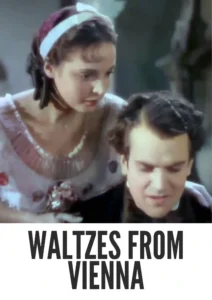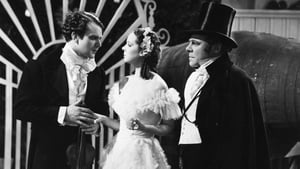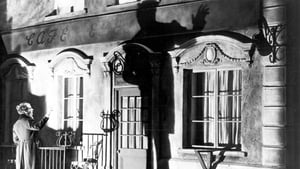Contact: [email protected]
Video Sources 0 Views
- Waltzes from Vienna


Synopsis
Table of Contents
ToggleReview: Waltzes from Vienna (1934) – A Melodic Journey through Love and Ambition

Introduction
“Waltzes from Vienna” (1934) offers audiences a melodious escape into the world of love, ambition, and timeless music. In this article, we’ll explore the significance of this musical gem, its historical context, and its enduring charm in the world of cinema.
Check The Full Colorized Movies List
Check Our Colorized Movies Trailer Channel
Understanding Waltzes from Vienna 1934: Director, Cast, and Genre
Directed by the renowned Alfred Hitchcock, “Waltzes from Vienna” (1934) showcases his versatility in storytelling beyond his iconic suspense thrillers. The film features an ensemble cast, with notable performances by Jessie Matthews and Esmond Knight, who bring the romantic and dramatic elements of the story to life. Blending elements of romance, comedy, and musical, “Waltzes from Vienna” (1934) transports viewers to the enchanting world of 19th-century Vienna, where passion and ambition collide against the backdrop of Johann Strauss II’s timeless melodies.
Exploring the World of Waltzes from Vienna 1934: Plot and Characters
At its heart, “Waltzes from Vienna” (1934) follows the journey of Johann Strauss II, the legendary composer known as the “Waltz King,” and his tumultuous relationship with his father. As Johann strives to establish himself as a respected composer in his own right, he must navigate the complexities of family expectations, artistic ambition, and matters of the heart. Along the way, he encounters a colorful cast of characters, from fellow musicians to star-crossed lovers, each adding depth and dimension to his journey of self-discovery and musical innovation.
The Art of Film Colorization
Film colorization serves as a transformative tool that enhances the visual experience of classic movies, breathing new life into timeless stories and captivating audiences with vibrant hues. By digitally adding color to black and white films, colorization allows viewers to immerse themselves in the rich tapestry of cinematic worlds, exploring every nuance and detail with fresh eyes and renewed appreciation.
Early Colored Films: A Brief History
The history of colored films traces its roots back to the early days of cinema, with filmmakers experimenting with various techniques to add color to their creations. From hand-tinted frames to early Technicolor processes, the evolution of colored film has been marked by innovation and ingenuity, paving the way for the development of modern colorization techniques that continue to captivate audiences to this day.
Waltzes from Vienna 1934 and Its Early Colored Version
The decision to release “Waltzes from Vienna” (1934) in a colorized format was met with both excitement and trepidation. While some welcomed the opportunity to experience the film’s vibrant musical sequences in vivid color, others expressed concerns about the potential impact on its visual aesthetic. Nevertheless, the early colored version of “Waltzes from Vienna” (1934) offers viewers a fresh perspective on the timeless tale of love and ambition, enhancing its emotional resonance and captivating audiences with its luminous beauty.
The Debate Over Film Colorization
The debate over film colorization continues to divide audiences and critics alike, with proponents praising its ability to breathe new life into classic movies and introduce them to a new generation of viewers, while detractors argue that it compromises the artistic integrity of the original work and diminishes its historical significance. As the debate rages on, filmmakers and audiences alike are left to ponder the merits and drawbacks of colorization in the ever-evolving landscape of cinema.
Examining Waltzes from Vienna 1934 as an Early Colored Film
As with any colorized classic, the impact of colorization on “Waltzes from Vienna” (1934) is a matter of personal interpretation. Some may argue that it enhances the film’s visual appeal and immerses viewers in its world, while others may feel that it detracts from the stark beauty of the original black and white version. Regardless of one’s stance on the issue, there’s no denying the enduring power of “Waltzes from Vienna” (1934) as a timeless musical journey that continues to capture the hearts of audiences around the world.
Influence and Legacy: Waltzes from Vienna 1934’s Impact on Cinema
“Waltzes from Vienna” (1934) has left an indelible mark on the world of cinema, inspiring countless filmmakers and captivating audiences with its timeless melodies and captivating performances. From its unforgettable music to its sweeping cinematography, the film continues to resonate with viewers of all ages, reaffirming its status as a beloved classic of the musical genre.
Director’s Cinematic Legacy: Beyond Waltzes from Vienna 1934
Alfred Hitchcock’s influence extends far beyond his iconic suspense thrillers, with “Waltzes from Vienna” (1934) showcasing his versatility and artistic vision. While the film may not be as well-known as some of his other works, it remains a testament to his skill as a storyteller and his ability to transcend genre conventions. Through his groundbreaking work, Hitchcock has left an indelible imprint on the world of cinema, inspiring generations of filmmakers to follow in his footsteps.
Themes Explored in Waltzes from Vienna 1934
“Waltzes from Vienna” (1934) explores a myriad of themes, from the pursuit of artistic passion to the complexities of family dynamics and the transformative power of music. Through its richly drawn characters and evocative storytelling, the film invites viewers to ponder the timeless truths that bind us together and the universal language of love and music that transcends all barriers.
Reception and Controversy Surrounding Waltzes from Vienna 1934
Upon its release, “Waltzes from Vienna” (1934) received widespread critical acclaim, with many praising its enchanting musical sequences, heartfelt performances, and lush cinematography. However, the decision to release the film in a colorized format sparked debate among purists, reigniting the age-old discussion surrounding film preservation and artistic integrity. Despite the controversy, “Waltzes from Vienna” (1934) remains a beloved classic that continues to resonate with audiences of all ages, reaffirming its status as a timeless masterpiece of the musical genre.
Where to Watch Waltzes from Vienna 1934 Online
For those eager to experience the timeless magic of “Waltzes from Vienna” (1934), the film is readily available on popular streaming platforms such as Netflix, Amazon Prime, and Hulu. Whether you choose to watch it in its original black and white format or the early colored version, “Waltzes from Vienna” (1934) promises to transport you to a world of romance, passion, and musical enchantment.
FAQs About Waltzes from Vienna 1934
Q: Is “Waltzes from Vienna” (1934) based on a true story? A: No, “Waltzes from Vienna” (1934) is a fictional tale inspired by the life and music of Johann Strauss II, the legendary composer known as the “Waltz King.”
Q: Who are the main actors in “Waltzes from Vienna” (1934)? A: “Waltzes from Vienna” (1934) features an ensemble cast led by Jessie Matthews and Esmond Knight, whose on-screen chemistry and musical talents bring the story to life with passion and charm.
Q: What awards did “Waltzes from Vienna” (1934) win? A: While “Waltzes from Vienna” (1934) did not win any major awards, it received critical acclaim for its enchanting musical sequences, heartfelt performances, and lush cinematography.
Q: Why was “Waltzes from Vienna” (1934) released in a colorized format? A: The decision to release “Waltzes from Vienna” (1934) in color was made to introduce the film to a new generation of viewers and enhance its visual appeal for modern audiences. While the choice to colorize the film sparked debate among purists, it ultimately allowed “Waltzes from Vienna” (1934) to reach a wider audience and ensure its continued relevance in the annals of cinematic history.
Conclusion
“Waltzes from Vienna” (1934) remains a timeless musical journey that continues to captivate audiences with its enchanting melodies, heartfelt performances, and lush cinematography. Whether viewed in its original black and white format or the early colored version, the film serves as a testament to the enduring power of love, passion, and the transformative magic of music. So, whether you’re a seasoned cinephile or a casual moviegoer, take a moment to experience the timeless charm of “Waltzes from Vienna” (1934) and embark on a melodic journey through the heart of 19th-century Vienna.











